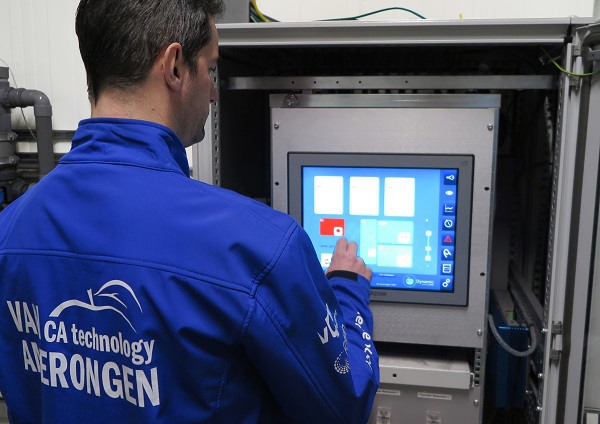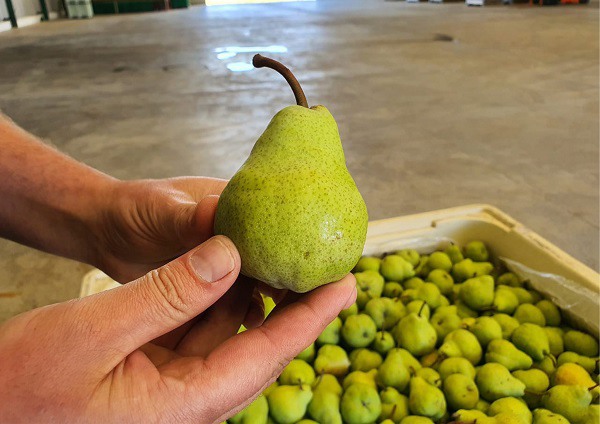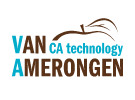Apples and pears stored in a standard ULO (Ultra Low Oxygen) cell already benefit greatly. These facilities have fixed oxygen (O2) and carbon dioxide (CO2) levels. However, using dynamic storage appears to yield even better results, explains Niels Remmelink of Van Amerongen CA Technology. This Dutch company specializes in fruit and vegetable storage. "The Advanced Control Respiration (ACR) system measures a product's respiration - its oxygen intake and the CO2 production - over a certain period."

Inspection of the ARC system
"Based on that, it's determined whether the oxygen level can be further reduced, should remain the same, or should be increased." The aim is to arrive at the fruit's lowest acceptable oxygen value. Niels says storage in extremely low oxygen conditions has several advantages. "The stored fruit become firmer. With Elstar apples, it can prevent brown skin spots. And in Granny Smiths, it prevents the disease, Skald, that makes apples unsellable." Another plus is that post-harvest fruit treatments can be avoided.
"Growers in South Africa's apples remain firm while on shelves without using 1-MCP (known on the market as Smart Fresh, among others). They achieve this by storing them at very low oxygen levels. If dynamic storage gets comparable or improved results, it affects costs." There's another cost advantage. "The stored fruit respires less, so produces less heat. That means it needs to be cooled down less often, which in turn reduces energy consumption."
Automatic measurements
Farmers first store the harvested product in standard ULO conditions. After some time, depending on the product's condition, dynamic storage is applied. The ACR system then automatically takes measurements once every three days and adjusts the values accordingly. "It's important to have a few days between measurements. The fruit must have time to adjust to the new oxygen concentration," continues Remmelink.
Several aspects can affect fruits' minimum tolerable oxygen levels. These include the apple's origin, climate conditions during cultivation, and the batch's variety and uniformity. This preservation method should, therefore, preferably be used on uniform batches of fruit, ideally from a single origin. In the Netherlands, dynamic storage is mainly applied to apples. The ACR system is widely used in South Africa, Australia, and Portugal.

There, fruit like Packham, Trout, and Rocha pears are also stored under extremely low oxygen levels. It seems Conference pears are less suited to storage at lower oxygen values. In Belgium and elsewhere, they're now testing which other ratios, like CO2 values, can be adjusted in combination with lower oxygen levels. These first results are promising, says Niels.
Safety margins
Optimization is central to dynamic storage. The lowest possible oxygen content offers advantages, but too-low values can damage the fruit. "If you drop the oxygen levels too low, the fruit starts fermenting. That can damage the apples and pears. If that goes on too long, the taste and quality are affected, and then you can't sell them. The ACR system aims to drop the oxygen levels as low are safely possible." The system, therefore, has several built-in safety margins. For example, it takes measurements in two places in the cell.
Oxygen meters are extra accurate, and the system does additional calibrations to prevent incorrect measurements. "Several conditions must be met before the system approves a measurement." You can set limits too, on, say, how quickly oxygen is reduced or a minimum oxygen value. "That can be customized. Some clients already have six years of experience in this. They know their product and the ACR system inside out. They rely on the ACR system to determine/measure respiration and, therefore, reduce the oxygen level," concludes Niels.
 Niels Remmelink
Niels Remmelink
NRemmelink@van-amerongen.com
Van Amerongen CA Technology
Biezenwei 6
4004 MB Tiel, The Netherlands
+31 344 670 570
info@van-amerongen.com
www.van-amerongen.com
